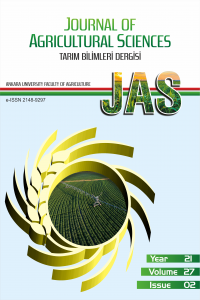Balkabağı Cucurbita pepo L. ve Karpuz Citrullus lanatus L. Tohumlarının Bazı Fiziksel Özellikleri
Kabak Cucurbita pepo L. tohumu ve karpuz Citrullus lanatus L. tohumu, fiziksel özellikler
Some Physical Properties of Pumpkin Cucurbita pepo L. and Watermelon Citrullus lanatus L. Seeds
___
- Altuntas, E., E. Ozgoz and O. F. Taser. 2005. Some physical properties of fenugreek (Trigonella foenum-graceum L.) seeds. Journal of Food Engineering 71: 37-43.
- Altuntas, E. and H. Demirtola. 2007. Effect of moisture content on physical properties of some grain legume seeds. New Zealand Journal of Crop and Horticultural Science 35(4): 423-433.
- Altuntas, E. and Y. Karadag. 2006. Some physical and mechanical properties of sainfoin (Onobrychis sativa Lam.), grasspea (Lathyrus sativus L.) and bitter vetch (Vicia ervilia (L.) Willd.) seeds. Journal of Applied Science 6(6): 1373-1379.
- Amin, M. N., M. A. Hossain and K.C. Roy. 2004. Effects of moisture content on some physical properties of lentil grains. Journal of Food Engineering 65: 83-87.
- Artwatermelon, 2007. http://www.foodreference.com. Accessed to web: 12.09.2007.
- Baryeh, E. A. 2002. Physical properties of millet. Journal of Food Engineering 51: 39-46.
- Deshpande, S. D., S. Bal and T. P. Ojha. 1993. Physical properties of soybean grains. Journal of Agricultural Engineering Research 56: 89-92.
- FAO, 2005. Statistical database. http://faostat.fao.org. Accessed to web 12.11.2007.
- Herbs_Pumkin, 2007.http://www.herbs2000.com/herbs. Accessed to web, 21.10.2007.
- Hopkins,S.2007.Watermelon_An_Ingredient_For_Skin_Care. http://www.redsofts.com/articles/read/460/2448. Accessed to web, 31.10.2007.
- Kaleemullah, S. and J. J. Gunasekar. 2002. Moisture- dependent physical properties of arecanut trues. Biosystem Engineering 82 (3): 331-338.
- Kara, M., N. Turgut, Y. Erkmen and İ. E. Güler. 1997. Determination of coefficient of friction of some granules. 17 National Symposium on Mechanization in Agriculture. (pp. 609-614). Tokat. Turkey (in Turkish).
- Kasap A, and E. Altuntas. 2006. Physical Properties of Monogerm Sugarbeet (Beta vulgaris var. altissima) seeds. New Zealand Journal of Crop and Horticultural Science 34: 311-318.
- Mohsenin, N. N. 1970. Physical properties of plant and animal materials. Gordon and Breach Science Publishers, New York.
- Ogunjimi, L. A. O., N. A. Aviara and O. A. Aregbesola. 2002. Some engineering properties of locust bean seed. J.Food Engineering 55: 273-277.
- Olajide, J. D. and B. I. O. Ade-Omowaye. 1999. Some physical properties of locust bean seed. Journal of Agricultural Engineering Research 74 (2): 213-215.
- Ozarslan, C. 2002. Some physical properties of cotton grain. Biosystems Engineering 83 (2): 169-174.
- Ozgoz, E., O. F. Taser and E. Altuntas. 2005. Some Physical properties of Yarma Bulgur. Journal of Applied Science 5(5): 838-840.
- Sacilik, K., R. Öztürk and R. Keskin. 2003. Some physical properties of hemp grain. Biosystems Engineering 86 (2): 213-215.
- Sitkei, G. 1976. Mechanic of Agricultural Materials. Akademia Kiado, Budapest.
- Sönmez, N., H. H. A. Alizadeh, R. Öztürk and A. İ. Acar. 2007. Some Physical Properties of Gilaburu Seed. Journal of Agricultural Machinery Science. Vol:13, Number:3: 308-311.
- Suthar, S. H. and S. K. Das. 1996. Some physical properties of karingda [Citrus lanatus (thumb) mansf] grains. Journal of Agricultural Engineering Research, 65(1),15- 22.
- Taser, O. F., E. Altuntas and E. Ozgoz. 2005. Physical properties of Hungarian and common vetch seeds. Journal of Applied Science 5(2): 323,326.
- Tunde-Akindute, T. Y. and B. O. Akindute. 2004. Some physical properties of sesame seed. Biosystems Engineering 88: 127-129.
- Vilche, C., Gely, M., and E. Santalla (2003). Physical properties of quinoa grains. Biosystems Engineering 86 (1): 59-65.
- Viswanathan, P. T., L. Palanisamy and E. Sreenarayanan. 1996. Physical properties of neem nut. Journal of Agricultural Engineering Research 63: 19-26.
- Watermelon, 2007.http://www.kalyx.com/store/proddetail.cfm. Accessed to web, 21.10.2007.
- ISSN: 1300-7580
- Yayın Aralığı: Yılda 4 Sayı
- Başlangıç: 1995
- Yayıncı: Ankara Üniversitesi
Ankara Keçisi Oğlaklarında Tiroit Hormonlarının Serum Düzeylerinin Değişimi
Balkabağı Cucurbita pepo L. ve Karpuz Citrullus lanatus L. Tohumlarının Bazı Fiziksel Özellikleri
Çivril Bölgesinde Yetişen Üstün Özellikli Ünnap Ziziphus jujuba L. Genotiplerinin Seleksiyonu
Fevzi M. ECEVİT, Bekir ŞAN, Tuba DİLMAÇ ÜNAL, Filiz HALLAÇ TÜRK, Adnan N. YILDIRIM, Mehmet POLAT, Fatma YILDIRIM
Sulama Amaçlı Hazne Kapasitesinin Belirlenmesinde Çeşitli Yöntemlerin Karşılaştırılması
Mohammad T. SATTAR, Farzin SALMASİ, Fazlı ÖZTÜRK
Van İli Gürpınar İlçesinde Yem Bitkileri Üretimi ve Sorunları Üzerine Bir Araştırma
Ethephon Uygulamasının Tritikale Çeşitlerinde Verim ve Verim Unsurlarındaki Etkilerinin Belirlenmesi
Fitotoxinlerin Bitki Hastalıklarındaki Rolü
